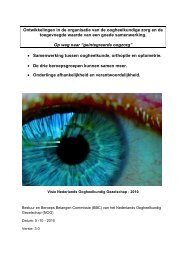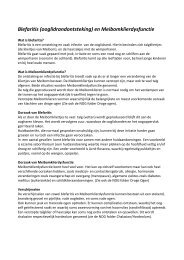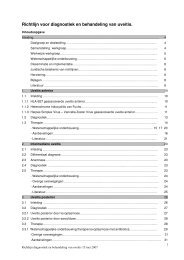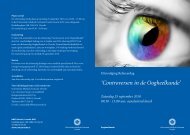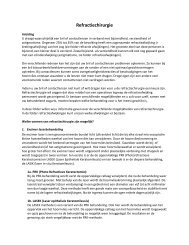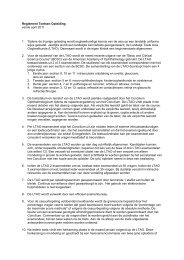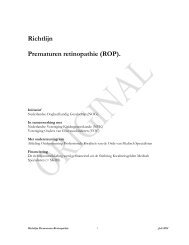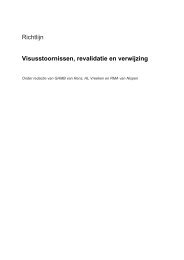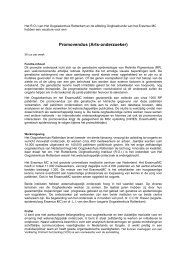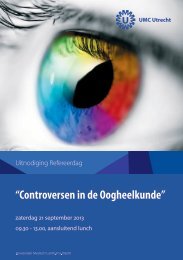terminology and guidelines for glaucoma ii - Kwaliteitskoepel
terminology and guidelines for glaucoma ii - Kwaliteitskoepel
terminology and guidelines for glaucoma ii - Kwaliteitskoepel
You also want an ePaper? Increase the reach of your titles
YUMPU automatically turns print PDFs into web optimized ePapers that Google loves.
3.5.2 - LASER TRABECULOPLASTY 77-89<br />
Indications:<br />
POAG, exfoliative <strong>and</strong> pigmentary <strong>glaucoma</strong> when IOP is not satisfactorily controlled with medications, where the<br />
latter are contraindicated, or where compliance is a problem, such as in the elderly.<br />
Should initial medical therapy fail to control the patient`s <strong>glaucoma</strong>, ALT could be offered <strong>for</strong> patients with heavily pigmented trabecular<br />
meshwork <strong>and</strong> <strong>for</strong> those patients who are infirm, elderly, or have a short life expectancy.<br />
Preoperative preparation:<br />
- prevention of IOP spikes: topical apraclonidine 1% <strong>and</strong>/or oral acetazolamide one hour prior to the procedure<br />
<strong>and</strong> immediately afterwards<br />
- topical anaesthesia<br />
Procedure:<br />
Argon laser (Green or Blue/Green)<br />
Diode laser<br />
Lenses:<br />
- Goldmann type gonioscopy lens<br />
- Ritch trabeculoplasty lens ©<br />
- CGA © Lasag<br />
• Identify angle l<strong>and</strong>marks<br />
• Laser burns placed between the anterior pigmented trabecular meshwork <strong>and</strong> the non-pigmented trabecular<br />
meshwork ie mid to anterior third of the trabecular meshwork over 180 or 360 degrees.<br />
If necessary, repeat 2 weeks later over the other 180 degrees if only half circumference was initially treated.<br />
When electing to per<strong>for</strong>m two sessions of 180 degrees, make sure not to repeat the treatment in the same quadrant.<br />
Laser parameters:<br />
Spot Size: 50 µm<br />
Exposure time: 0.1 seconds<br />
Power:<br />
500-1200 mW according to the reaction on the trabecular<br />
meshwork<br />
Optimal reaction: transient blanching or small gas bubble <strong>for</strong>mation<br />
Complications:<br />
Transient decrease in visual acuity due to gonioscopy contact fluid, inflammation, significant IOP elevation<br />
Transient iritis<br />
Early <strong>and</strong> transient IOP elevations<br />
Visual field loss as a consequence of IOP spikes<br />
Peripheral anterior synechiae, especially after posteriorly placed burns, or a narrow drainage angle<br />
Late IOP rise due to loss of effect (not infrequent after longer follow-up)<br />
Post-operative management:<br />
- Check the IOP during the first 1-6 hours. If this is not possible, treat with oral CAIs <strong>and</strong> α 2 agonists to prevent<br />
IOP spikes in susceptible patients.<br />
- Topical corticosteroids or non-steroidal anti-inflammatory agent TID or QID <strong>for</strong> 4-7 days.<br />
Close monitoring is suggested in the following cases: advanced <strong>glaucoma</strong>tous optic nerve damage with severe field<br />
loss, one-eyed patients, high pre-laser IOP, exfoliation syndrome, previous laser trabeculoplasty<br />
Ch. 3 - 30 EGS



